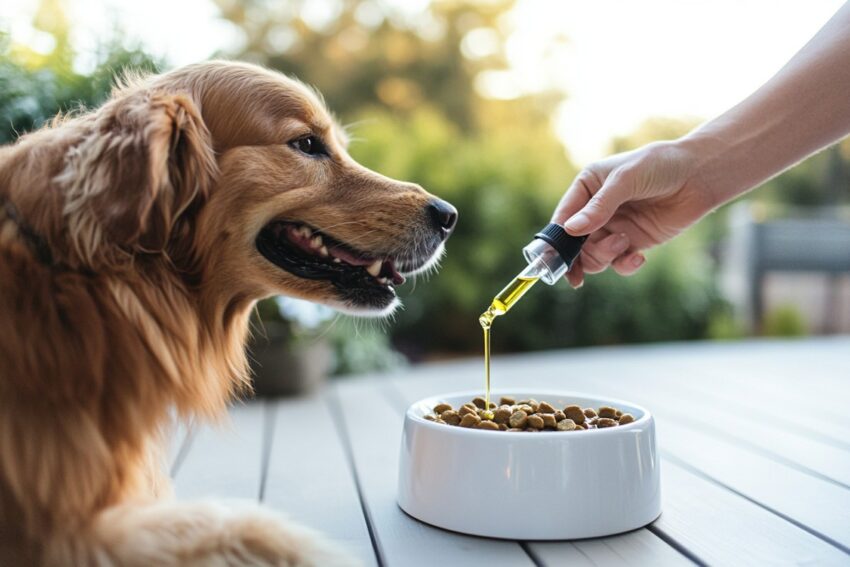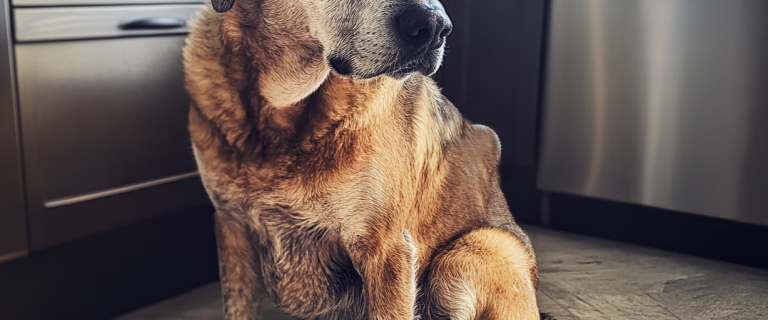If your dog’s skin seems itchy, their coat looks dull, or they’re slowing down on walks, salmon oil might be the simple upgrade that changes everything.
This omega-3-packed supplement has quickly become a go-to for pet parents who want shinier fur, fewer flakes, and smoother movement—without relying on harsh meds.
Let’s break down what makes salmon oil for dogs such a powerful tool in your wellness toolbox.
Quick Look: Why Pet Parents Love Salmon Oil for Dogs
- • Soothes dry, itchy skin: Helps with allergies and seasonal shedding.
- • Boosts coat shine: Reduces excessive shedding for a sleek, glossy look.
- • Supports joint health: Great for aging or active pups.
💡 Why keep reading? Find out how to choose the purest salmon oil, the right dosage, and the visible changes you can expect in your dog.
Looking for more healthy additions to your dog's diet?
You may also like: 7 Best Dog Vitamins & Supplements To Enhance Your Dog’s Health
The Core Benefits of Salmon Oil for Dogs
1. Skin Soothing Power
Is your dog always scratching, licking, or dealing with flaky skin?
Salmon oil is rich in omega-3 fatty acids (EPA and DHA), which naturally reduce inflammation and support the skin barrier. This helps:
- Calm itchy, irritated skin
- Reduce allergic reactions
- Minimize hot spots and dryness
Pro Tip:
Start with a small dose and build up. You may see noticeable skin improvements in 2–4 weeks.
2. Shinier, Stronger Coat
Dull coat? Excess shedding? Salmon oil feeds your dog’s fur from the inside out.
Thanks to those omega-3s, you can expect:
- A glossier, softer coat
- Less breakage and shedding
- A healthy glow even in dry winter months
It’s one of the most noticeable changes pet parents rave about—especially for breeds prone to dryness or double coats.
3. Joint Health & Mobility Boost
If your dog’s moving slower or showing signs of stiffness, salmon oil can help turn back the clock.
Its anti-inflammatory benefits support joint lubrication and cartilage protection, helping to:
- Ease discomfort from arthritis
- Support recovery after active play
- Improve mobility in senior dogs
🩺 Vet Tip: Combine salmon oil with glucosamine or chondroitin for a powerful joint-care routine.
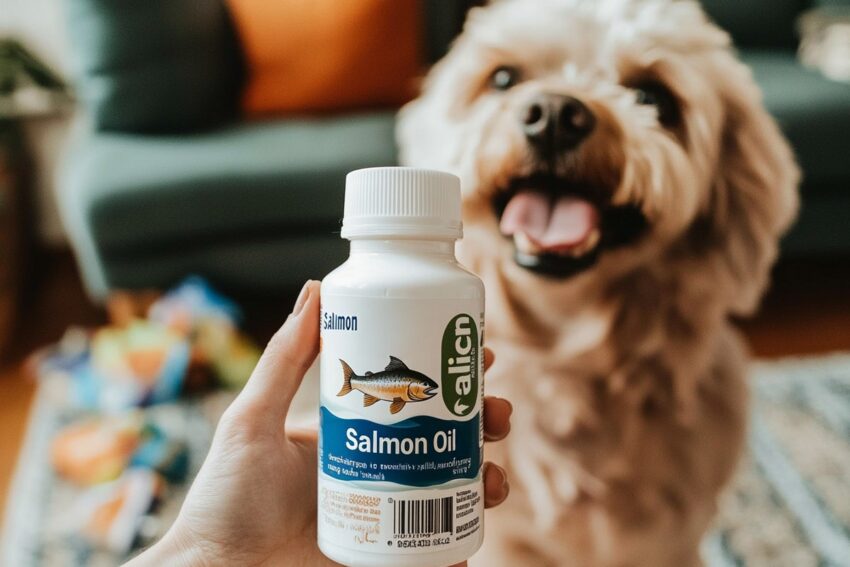
What Makes Salmon Oil So Powerful?
The magic behind salmon oil lies in its omega-3 fatty acids, particularly two heavy hitters:
EPA (Eicosapentaenoic Acid)
- Fights inflammation at the cellular level
- Supports heart and immune function
- Reduces skin irritation and redness
DHA (Docosahexaenoic Acid)
- Supports brain development in puppies
- Helps senior dogs with cognitive health
- Aids in overall skin and coat condition
Together, EPA and DHA work as natural anti-inflammatories—without the side effects of medication. They also help balance out omega-6 fatty acids found in typical dog foods, which can trigger inflammation if left unchecked.
Hot Tip:
Not all oils are created equal. Look for products that list both EPA and DHA content on the label so you know exactly what your pup’s getting.
Wild-Caught vs. Farmed Salmon: Does It Matter?
When you’re buying salmon oil for your dog, the label might not scream “big decision”—but trust us, it is.
The source of the salmon plays a huge role in how beneficial (or potentially harmful) the oil can be.
Wild-caught vs. farmed isn’t just a price difference—it’s about purity, potency, and peace of mind.
Let’s break it down:
Wild-Caught Salmon Oil
✅ Lower in contaminants like mercury and PCBs
✅ Naturally higher in beneficial omega-3s
✅ Sourced from the ocean, not crowded pens
✅ Usually more eco-conscious if labeled “sustainably caught”
Best for: Dogs with allergies, sensitive systems, or long-term supplementation
Sustainably sourced from Bristol Bay, Alaska, this premium salmon oil delivers a powerful dose of omega-3s to support your pet’s skin, coat, joints, heart, and brain. Rich in EPA, DHA, and astaxanthin, it helps reduce itching, shedding, and inflammation—while boosting overall wellness from nose to tail. Great for both dogs and cats!
Farmed Salmon Oil
⚠️ May contain higher levels of contaminants like PCBs and dioxins
⚠️ Often has a lower omega-3 to omega-6 ratio
⚠️ Fish may be exposed to antibiotics and less natural diets
⚠️ Environmental concerns from large-scale fish farming
Best for: Pet parents on a budget who still want the benefits of salmon oil—look for brands that test for contaminants and use responsible farming practices.
Sustainably sourced from Norwegian farmed Atlantic salmon, this human-grade oil supports skin, coat, and joint health while reducing food waste.
What to Look For on the Label:
- “Wild-caught” or “sustainably sourced” clearly stated
- Cold-pressed extraction method
- Third-party purity testing or QR-code for lab reports
Pro Tip:
How to Choose a High-Quality Salmon Oil
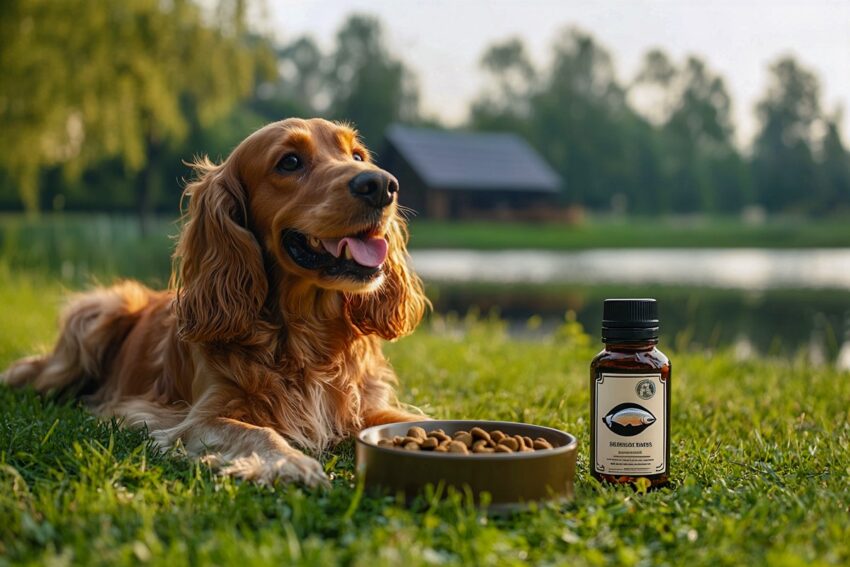
With more and more pet parents jumping on the salmon oil train, the market is full of options—some fantastic, others… not so much. Choosing the right one makes all the difference in your dog’s results and long-term health.
Here’s what to look for (and what to avoid) when scanning those labels:
The Must-Haves: What Makes a Salmon Oil Worth It
Wild-Caught Sourcing
Choose salmon oil made from wild-caught salmon, not vague “marine fish blends.” Wild sources are naturally higher in omega-3s and lower in toxins like mercury or PCBs.
Cold-Pressed Extraction
Cold-pressing keeps the oil’s nutrients intact. Avoid products processed with heat or chemicals—they may lose potency before they even reach your dog’s bowl.
Clear EPA & DHA Content
The label should clearly show how much EPA and DHA is in each serving. These are the omega-3s doing the real work—reducing inflammation and improving skin and joint health.
Third-Party Testing
Reputable brands test for contaminants and post results online or include QR codes on the label. If they’re not transparent, that’s a red flag.
What to Avoid: Sneaky Add-Ins and Red Flags
Unclear Labeling
If it just says “fish oil” or “ocean-sourced blend,” skip it. You want to know exactly what’s going into your dog’s body.
Artificial Additives
Watch out for added flavors, dyes, or preservatives. A clean salmon oil won’t need to be dressed up.
Cheap Packaging
Clear plastic bottles can degrade quality. Look for dark glass or BPA-free containers that protect from light and oxidation.
Pro Tip:
How Much Salmon Oil Should You Give Your Dog?
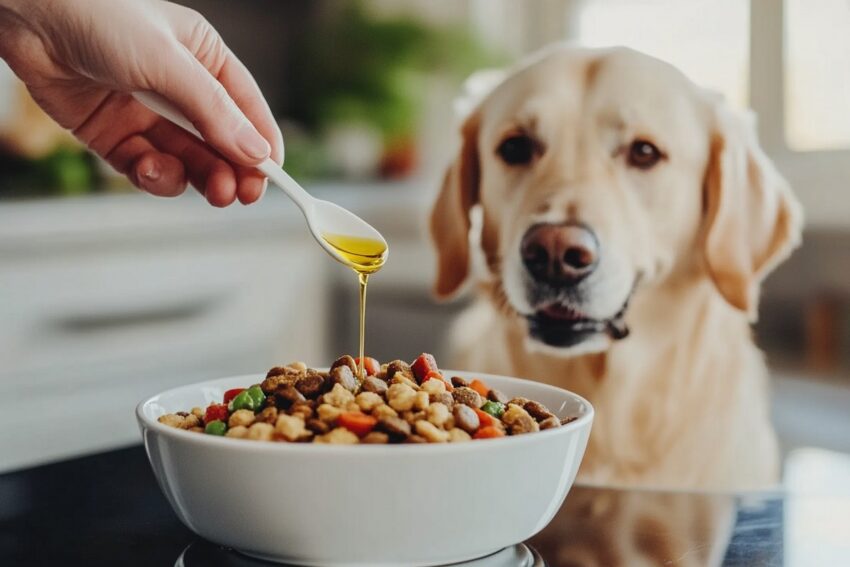
The right dose of salmon oil depends on your dog’s size, health needs, and how concentrated the product is. Too little won’t deliver results—but too much can cause tummy trouble or excess calories.
Here’s how to find the sweet spot:
General Salmon Oil Dosage by Dog Size
| Dog Size | Weight Range | Daily EPA/DHA Amount |
|---|---|---|
| Small | Under 20 lbs | 250–500 mg |
| Medium | 20–50 lbs | 500–1,000 mg |
| Large | 50–100 lbs | 1,000–2,000 mg |
| Giant | 100+ lbs | Up to 3,000 mg |
💡 Always check your product’s label — it should list the EPA/DHA content per teaspoon or pump.
Start Slow and Watch for Changes
When adding salmon oil to your dog’s diet for the first time:
- Begin with half the recommended dose for the first 3–5 days
- Mix it into food to avoid picky-eater pushback
- Watch for signs of loose stool or fishy burps—if that happens, reduce the dose or split it between meals
Most pet parents report visible improvements in coat shine, skin comfort, or mobility within 2 to 4 weeks of daily use.
Pro Tip:
Dogs with chronic allergies or arthritis may benefit from slightly higher doses—but always check with your vet first if your dog has existing health conditions.
Final Thoughts: A Simple Boost With Big Benefits
Giving your dog salmon oil might seem like a small change—but it can have a major impact on how they look, feel, and move every day.
Whether your pup is dealing with itchy skin, shedding like crazy, or starting to show signs of joint stiffness, salmon oil delivers real, visible support from the inside out.
It’s an easy way to care deeper—and smarter—without turning to harsh medications or expensive treatments.
Author
-
Hey there, I'm Jamey, and I've been an animal lover for as long as I can remember. Growing up on a 50-acre farm in Ontario, Canada, I was surrounded by a menagerie of furry friends, from beloved cats and dogs to goats, horses, cows, and even chickens. Now, I call Victoria, British Columbia my home, and my heart belongs to my adorable Balinese cat, Milo. When I'm not editing blog posts here at DogVills, I enjoy helping solo entrepreneurs with their passion projects and online marketing. Over the years, I've also ventured into creating and selling various blogs.
View all posts
